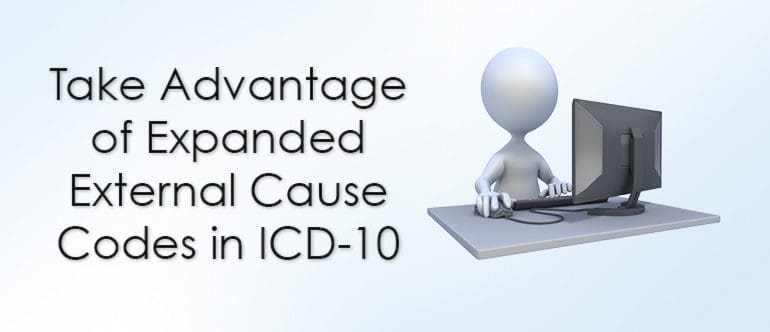Call us toll-free: 800-878-7828 — Monday - Friday — 8AM - 5PM EST

By Cathie Wilde, RHIA, CCS, AHIMA-Approved ICD-10-CM/PCS trainer for ICD10 monitor
Monday, 11 January 2016
During the transition to ICD-10, external cause codes – the codes that capture specific details about an injury or health event – received a bad reputation.
Many ICD-10 naysayers highlighted what they viewed as the absurdity of them. In an effort to thwart ICD-10 progress, they focused on the unlikely event that many of these external cause codes would ever be reported, diminishing the importance of the new coding system in general.
In reality, most of us recognize that causes of injury are incredibly varied. Although motor vehicle accidents, near-drownings, and falls are common, it’s certainly not out of the realm of possibility to be injured while walking into a lamppost or being struck by a bird, for example. According to the Centers for Disease Control and Prevention (CDC), injuries are the leading cause of death among individuals ages 1-44. Nearly 193,000 deaths occur from injuries annually. The CDC has published specific data related to the 10 leading causes of injury-related deaths by age group.
Importance of External Cause Codes
Being able to capture injury-related information via coded data (i.e., cause and intent, place of occurrence, activity, and status) not only enables the CDC to track valuable information, but it also helps state departments of public health to improve injury prevention and control. Many states use external cause data to assess injury prevalence, trends, and other risk factors. Other entities using these codes include the following:
- Payers (particularly when making determinations related to worker’s compensation claims)
- State legislators (to improve safety laws)
- Members of the media (to inform the public)
- Other state agencies, such as transportation departments and elementary and secondary school departments
- Health and community advocates
Individual organizations may also use external cause codes internally to improve processes. For example, if an organization notices a high volume of opioid overdoses, it may choose to launch a community action program. If an organization notices a high volume of falls within the facility’s bathrooms, it may need to reevaluate bathroom design and safety features.
There is no national requirement for mandatory ICD-10 external cause code reporting. However, many states and/or payers do require them. In the absence of mandatory reporting, it’s in every organization’s best interests to capture all or a portion of these codes to describe the circumstances of the patient’s injury or health event as accurately as possible.
ICD-9 versus ICD-10
There are two major differences between ICD-9 and ICD-10 with respect to external cause coding:
1. ICD-10 includes a seventh-character extension to identify the episode of care (i.e., initial, subsequent, or sequela). ICD-9 did not include this information.
2. ICD-10 includes combination codes for the following:
- Poisonings, adverse, and toxic effects, as well as underdosing. These codes include the cause and intent. For example, code T39.012A denotes poisoning by aspirin, intentional self-harm, initial encounter.
- Sequential events. ICD-10 codes have been expanded and provide more detail than those in ICD-9. For example, code W01.110A denotes a fall on same level from slipping, tripping, and stumbling with subsequent striking against sharp glass. Also, report W18.02XA to denote striking against glass with subsequent fall.
- Complications. For example, code K91.840 denotes post-procedural hemorrhage and hematoma of a digestive system organ or structure following a digestive system procedure. No external cause code is required in this case, as all information is captured in the diagnosis code itself.
Coding Tips
1. Consider these tips to ensure accurate external cause code reporting:
2. Know the requirements. Do certain payers or your state’s public health department require external cause codes? What is your facility’s specific policy regarding these codes? For example, some facilities capture the cause and place of occurrence, but not the activity or status.
Review the official coding guidelines. Refer to Section I.C.20. Important points include the following:
- External cause codes may be reported with any ICD-10-CM code to identify a health condition due to an external cause.
- Coders can assign as many external cause codes as necessary to fully explain each cause.
- Coders cannot assign an external cause code as a principal diagnosis.
- If the intent or cause of an injury or health event is unknown or unspecified, code to accidental.
- Unless otherwise specified, all transport accidents are accidental (intent).
- Use undetermined intent codes only if documentation specifically indicates that the intent cannot be determined.
- If the reporting format limits the number of external cause codes, give priority to cause and intent codes rather than codes to denote the place, activity, or external status.
3. Pay attention to non-provider documentation (e.g., nursing and social work notes, ambulance report, etc.). This documentation often provides greater insight into an injury or health event. Per Coding Clinic, First Quarter 2014, p. 19, coders may assign external cause codes based on non-physician documentation. However, if there is a conflict between the physician and non-physician documentation, the physician’s documentation takes precedence.
Adding Value Through Coded Data
Although there is no mandatory reporting of external cause codes, official coding guidelines do encourage providers to voluntarily report these codes, as they provide valuable data for injury research and evaluation of injury prevention strategies.
About the Author
Cathie Wilde, RHIA, CCS, is the director of coding services for MRA. Ms. Wilde has been active in the healthcare industry for more than 30 years. Her previous positions have included assistant director of HIM, DRG coordinator at the Massachusetts Hospital Association, and DRG validator at Blue Cross Blue Shield. She has extensive experience in ICD-9-CM and CPT coding, auditing, data analysis, development and testing of coding products, specialized reporting, and in-service training. Ms. Wilde is an American Health Information Management Association (AHIMA)-approved ICD-10-CM/PCS trainer.
